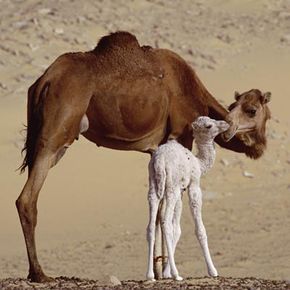No -- a camel's hump is a giant mound of fat, actually. In a healthy, well-fed camel, the hump can weigh as much as 80 pounds (35 kilograms)! Human beings and most animals store their fat mixed in with muscle tissue or in a layer right beneath the skin. Camels are the only animals with a hump.
The hump allows a camel to survive an extremely long time (up to two weeks) without food if need be. Because camels typically live in the desert, where food can be scarce for long stretches, this is important.
Advertisement
A camel uses about 5 gallons (20 liters) of water a day in the summer. However, a camel can lose up to 25 gallons (100 liters) of water from its body tissues without ill effects. One thing that a camel can do to conserve water is to handle large body-temperature swings. A camel might start the day at 94 degrees F and allow its temperature to rise as high as 105 degrees F. Only at the upper end of this range does it need to sweat to prevent overheating. When you compare this temperature range to the range the human body can handle (where only a 2 degree rise indicates illness), you can see the advantage.
Other camel facts:
- An adult camel weighs between 700 and 1,500 pounds (318 to 680 kg) and is up to 7 feet (2.1 meters) tall.
- Camels can live to be up to 50 years old.
- Camels gestate about 11 months and give birth to one calf.
- A male reaches maturity in five years, a female in three to four years.
- Camels actually have three eyelids! Two of them have lashes, and the third is thin.
- A camel can close its nostrils.
- A camel, like a goat, will eat almost anything.
- Pack camels can carry loads of 400 pounds 25 miles (181 kg 40 km) in a day.
Advertisement

